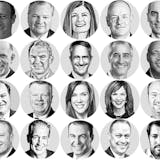Attorneys spent hours in a courtroom on Tuesday poring over maps of Minnesota, debating issues as sweeping as how people of color can participate in government to the intricacies of whether the path carved by the Elk River should divide communities in central Minnesota.
A five-judge panel is now considering those arguments in a case asking the courts to intervene and create the state's new redistricting maps. Tuesday's hearing was the final attempt from groups to influence the panel, which will now get to work in drawing what are likely to become the state's congressional and legislative maps for the next decade.
"To make sure every person's vote counts the same, we go through this process every 10 years," said Brian Dillon, an attorney representing plaintiffs in the case from communities of color. "The panel's job is to come up with new district boundaries that reflect where Minnesota's population is today. Not 10 years ago, or 10 years before that, but today."
The courts have been handling the job of drawing the political maps for the past five decades, when state lawmakers couldn't agree to plans on their own. That's expected to happen again this cycle, with Minnesota's divided Legislature far from agreement on a single set of maps and with limited time to do so before a Feb. 15 deadline.
It's a task required by the U.S. Constitution every decade after the census count to redistribute the population evenly among political districts. The stakes are high for communities navigating the new lines, as well as for the state's political parties, with redrawn boundaries scrambling election dynamics in districts for Congress and the state Legislature for a decade.
The four main parties in the case include representatives of communities of color, groups with ties to the state's two main political parties and another group led by citizen redistricting and elections experts that first asked the courts to intervene.
On Tuesday, each defended their own redistricting plans to the judges while picking apart what they argued were inadequacies in the other plans.
"We're focused less on statistics and more about what makes sense on the ground for the peoples and communities of this state," argued Adam Sienkowski, an attorney representing a group that includes a former Senate redistricting staffer and longtime Ramsey County elections supervisor.


